Imagine investing thousands of dollars in dental implants only to lose them because you didn’t know how to clean them properly. It happens more often than you’d think, and it’s completely preventable. The truth is, flossing dental implants isn’t just recommended—it’s absolutely essential for protecting your investment and maintaining your beautiful, confident smile for decades to come.
Your dental implants may be artificial, but the gums and bone supporting them are very much alive. Without proper care, bacteria can wreak havoc on these tissues, leading to complications that could cost you both your implants and your peace of mind. The good news? With the right techniques and tools, keeping your implants healthy is straightforward and manageable.
Key Takeaways
- Flossing dental implants is crucial for preventing peri-implantitis, a serious condition that can lead to implant failure
- Special flossing techniques and tools are required for implants, including water flossers, implant-specific floss, and interdental brushes
- Daily maintenance combined with regular professional cleanings can help your implants last 25+ years
- Proper technique matters more than frequency—learning the right way to clean around your implants protects your investment
- Early intervention for any signs of inflammation or bleeding can prevent costly complications down the road
Why Flossing Dental Implants Is Different from Natural Teeth
When you received your dental implants, you likely heard they’re designed to last a lifetime. While this is true, their longevity depends entirely on how well you care for them. Unlike natural teeth, dental implants don’t have the same protective mechanisms that help fight off bacteria and infection.
The Unique Structure of Dental Implants
Your natural teeth are surrounded by periodontal ligaments—tiny fibers that create a seal between your tooth and gum tissue. This biological seal helps prevent bacteria from traveling down into the deeper tissues. Dental implants don’t have this natural protection. Instead, they rely on direct contact between the gum tissue and the implant surface, making them more vulnerable to bacterial invasion.
The implant crown, abutment, and titanium post create small spaces and crevices where food particles and bacteria love to hide. Traditional brushing alone simply can’t reach these areas effectively, which is why specialized flossing techniques are absolutely essential.
What Happens When You Skip Flossing
Without proper cleaning, bacteria accumulate around your implant, leading to two serious conditions:
Peri-implant mucositis 🦠 affects the soft tissues around your implant, causing inflammation, redness, and bleeding. Think of it as gingivitis for implants—it’s reversible with proper care.
Peri-implantitis ⚠️ is the advanced stage where bacteria attack the bone supporting your implant. This condition can lead to bone loss and eventual implant failure, requiring costly removal and replacement procedures.
Studies show that peri-implantitis affects up to 22% of implant patients, but it’s almost entirely preventable with proper oral hygiene, including regular flossing.
Essential Tools for Flossing Dental Implants
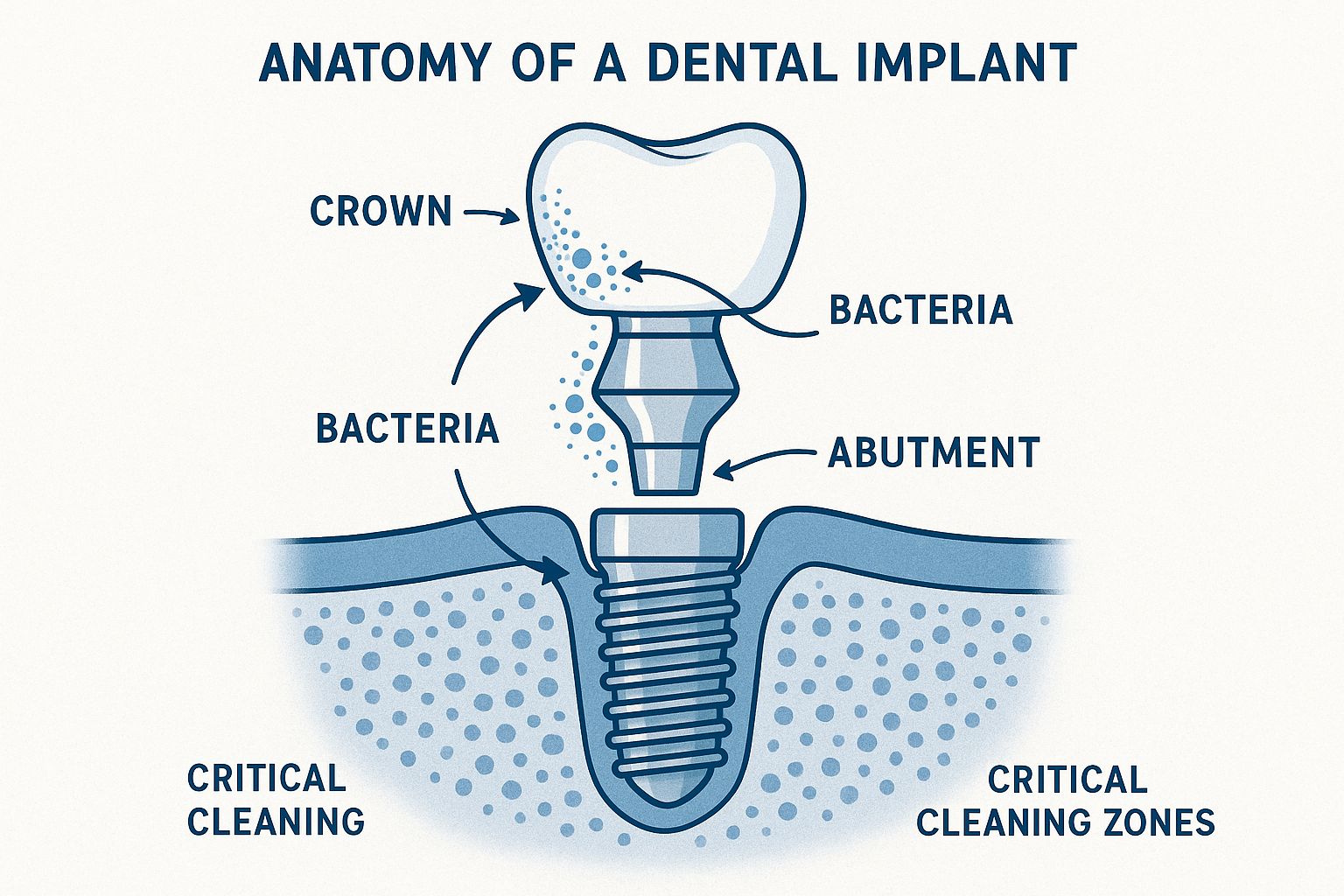
The tools you used to clean your natural teeth might not be the best choice for your implants. Here’s what dental professionals recommend for optimal implant care:
Water Flossers: Your Best Friend
Water flossers (also called oral irrigators) are game-changers for implant care. They use a pressurized stream of water to flush out bacteria and food particles from areas that traditional floss can’t reach effectively.
Benefits for implants:
- Gentle on sensitive gum tissue
- Reaches deep into implant crevices
- Reduces inflammation more effectively than string floss
- Easy to use around complex implant restorations
Top recommendations:
- Waterpik Aquarius Professional
- Philips Sonicare AirFloss Ultra
- Panasonic EW-DJ10 Portable Water Flosser
Implant-Specific Floss
Traditional floss can sometimes be too abrasive for implant surfaces. Implant-specific floss is designed with softer materials that won’t scratch your restoration while still effectively removing plaque.
Look for:
- PTFE (polytetrafluoroethylene) floss
- Implant floss with stiffened ends for easy threading
- Floss designed specifically for crowns and bridges
Interdental Brushes
These tiny bottle-brush-shaped tools are perfect for cleaning larger spaces around implants, especially if you have multiple implants or implant-supported bridges.
Sizing matters: Your dental hygienist can help you choose the right size. Too small won’t clean effectively; too large can damage your gums.
Daily Implant Care Tracker
Track your daily implant care routine to maintain optimal oral health
Morning Routine
Evening Routine
Today’s Progress
Step-by-Step Guide to Flossing Dental Implants
Now that you have the right tools, let’s walk through the proper technique for flossing your dental implants. Remember, technique matters more than frequency—doing it right once a day is better than doing it wrong multiple times.
Water Flossing Technique
Step 1: Prepare Your Water Flosser
- Fill the reservoir with lukewarm water
- Add antibacterial mouthwash if recommended by your dentist
- Start with the lowest pressure setting and gradually increase
Step 2: Position and Angle
- Lean over the sink to avoid mess
- Place the tip at a 90-degree angle to your gum line
- Start with the back teeth and work your way forward
Step 3: Clean Around Each Implant
- Pause at each implant for 3-5 seconds
- Trace along the gum line around the entire implant
- Pay special attention to the back side of implants, which are harder to reach
Step 4: Focus on Problem Areas
- Spend extra time on areas that tend to collect plaque
- Clean between multiple implants thoroughly
- Don’t forget the area where the implant meets the natural tooth
Traditional Floss Technique for Implants
If you prefer traditional floss or need to supplement your water flossing routine:
Threading Method:
- Use a floss threader or super floss with stiffened ends
- Gently thread the floss under the implant crown
- Move the floss in a C-shape around the implant
- Slide up and down gently—avoid aggressive sawing motions
- Clean both sides of the implant thoroughly
Important: Never force floss into tight spaces around implants. If you encounter resistance, try a thinner floss or consult your dental team.
Common Mistakes to Avoid When Flossing Dental Implants
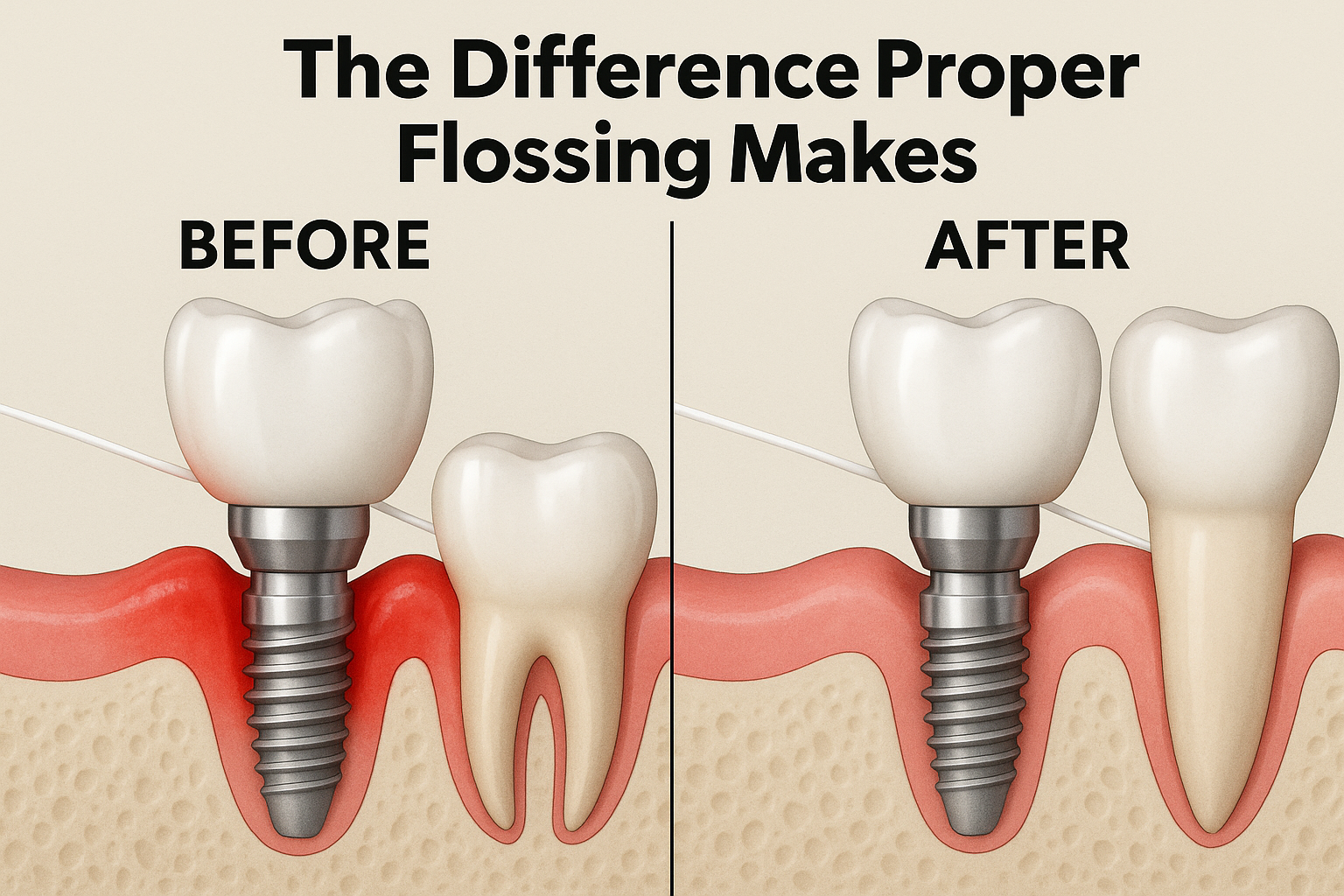
Even with the best intentions, many patients make mistakes that can damage their implants or reduce the effectiveness of their cleaning routine. Here are the most common pitfalls and how to avoid them:
❌ Using Too Much Pressure
The mistake: Thinking that more pressure equals better cleaning.
Why it’s harmful: Excessive pressure can damage the delicate seal between your gum and implant, creating pockets where bacteria can hide.
The solution: Use gentle, consistent pressure. Your gums shouldn’t bleed regularly from flossing. If they do, reduce pressure and consult your dental team.
❌ Skipping the Back Sides of Implants
The mistake: Only cleaning the easily accessible front and sides of implants.
Why it’s problematic: The back surfaces of implants are where most problems start because they’re harder to reach with regular brushing.
The solution: Always clean 360 degrees around each implant. Use a water flosser to reach difficult areas.
❌ Using Metal Instruments
The mistake: Using metal picks or instruments around implants.
Why it’s dangerous: Metal tools can scratch the implant surface, creating rough areas where bacteria can adhere more easily.
The solution: Stick to plastic interdental brushes, soft floss, and water flossers designed for implant care.
❌ Inconsistent Routine
The mistake: Flossing sporadically or only when you remember.
Why it matters: Bacterial biofilms form quickly around implants. Inconsistent cleaning allows these colonies to establish and mature.
The solution: Make flossing part of your daily routine, preferably at the same time each day.
Signs Your Implants Need Better Care
Your body will give you warning signs if your implant hygiene needs improvement. Early detection and intervention can prevent serious complications and save your implants. Here’s what to watch for:
🚨 Immediate Concerns
Bleeding during cleaning: While some initial bleeding is normal when you start a new flossing routine, persistent bleeding after 1-2 weeks indicates inflammation.
Swelling or redness: Healthy gum tissue around implants should be pink and firm, not red, swollen, or tender.
Bad taste or odor: Persistent bad taste or smell around your implants, even after cleaning, suggests bacterial buildup.
Pus or discharge: Any pus around your implants requires immediate professional attention.
⚠️ Progressive Warning Signs
Gum recession: If you notice more of your implant crown becoming visible over time, this could indicate bone loss.
Loose feeling: Implants should feel completely stable. Any movement or loose sensation needs immediate evaluation.
Pain or discomfort: While implants don’t have nerves, pain in the surrounding tissues can indicate infection or other complications.
Changes in bite: If your implant crown feels different when you bite down, it could indicate shifting or other problems.
Professional Care: What to Expect
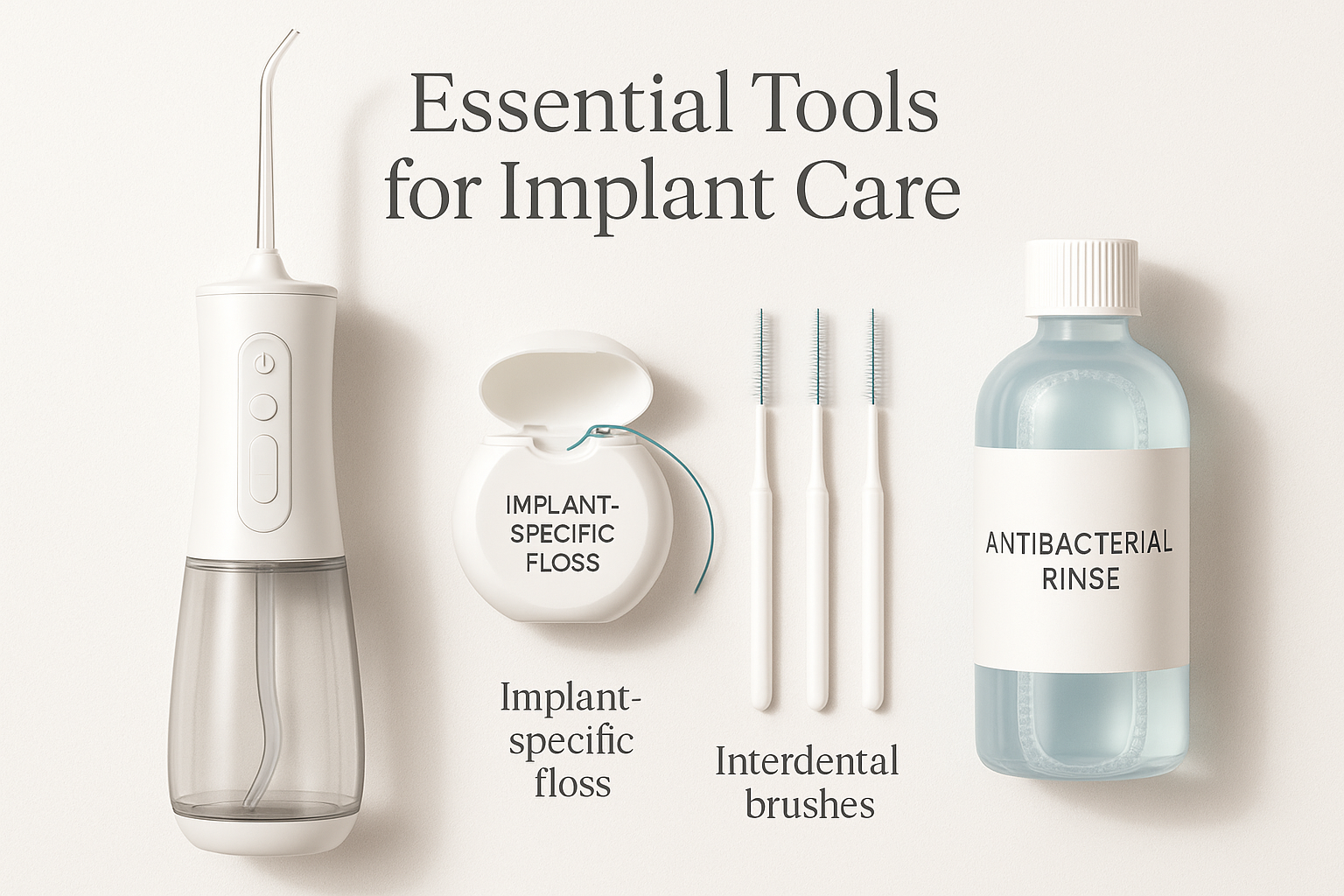
Even with perfect home care, regular professional maintenance is crucial for long-term implant success. Your dental care team will use specialized tools and techniques that you can’t replicate at home.
Professional Cleaning Schedule
First Year After Implant Placement:
- Cleanings every 3 months
- More frequent monitoring as tissues heal
- Adjustment of home care routine as needed
Long-term Maintenance:
- Professional cleanings every 3-6 months (depending on your risk factors)
- Annual implant-specific examinations
- Periodic X-rays to monitor bone levels
What’s Different About Implant Cleanings
Professional implant maintenance uses special instruments that won’t damage your implant surfaces:
Plastic scalers remove hardened plaque without scratching
Ultrasonic cleaners with special tips designed for implants
Polishing with non-abrasive compounds
Antimicrobial treatments to reduce bacterial loads
When to Seek Emergency Care
Some situations require immediate professional attention:
- Sudden pain or swelling around implants
- Visible pus or discharge
- Implant feels loose or mobile
- Severe bleeding that doesn’t stop with gentle pressure
- Signs of infection (fever, swollen lymph nodes)
Cost Considerations: Prevention vs. Treatment
Understanding the financial impact of proper implant care can motivate consistent daily maintenance. The cost difference between prevention and treatment is substantial.
Investment in Prevention
Annual prevention costs:
- Water flosser: $50-150 (one-time purchase)
- Implant-specific floss: $30-50 per year
- Professional cleanings: $400-800 annually
- Total annual investment: $480-1,000
Cost of Complications
Peri-implantitis treatment:
- Non-surgical therapy: $500-1,500 per implant
- Surgical intervention: $1,500-5,000 per implant
- Implant replacement: $3,000-6,000 per implant
Full mouth complications can cost $15,000-50,000 or more, especially if you need full mouth reconstruction or complete implant replacement.
Insurance and Payment Options
Most dental insurance plans cover routine implant maintenance, though coverage varies. Many practices offer payment plans for implant care to make ongoing maintenance more affordable.
Special Considerations for Different Implant Types
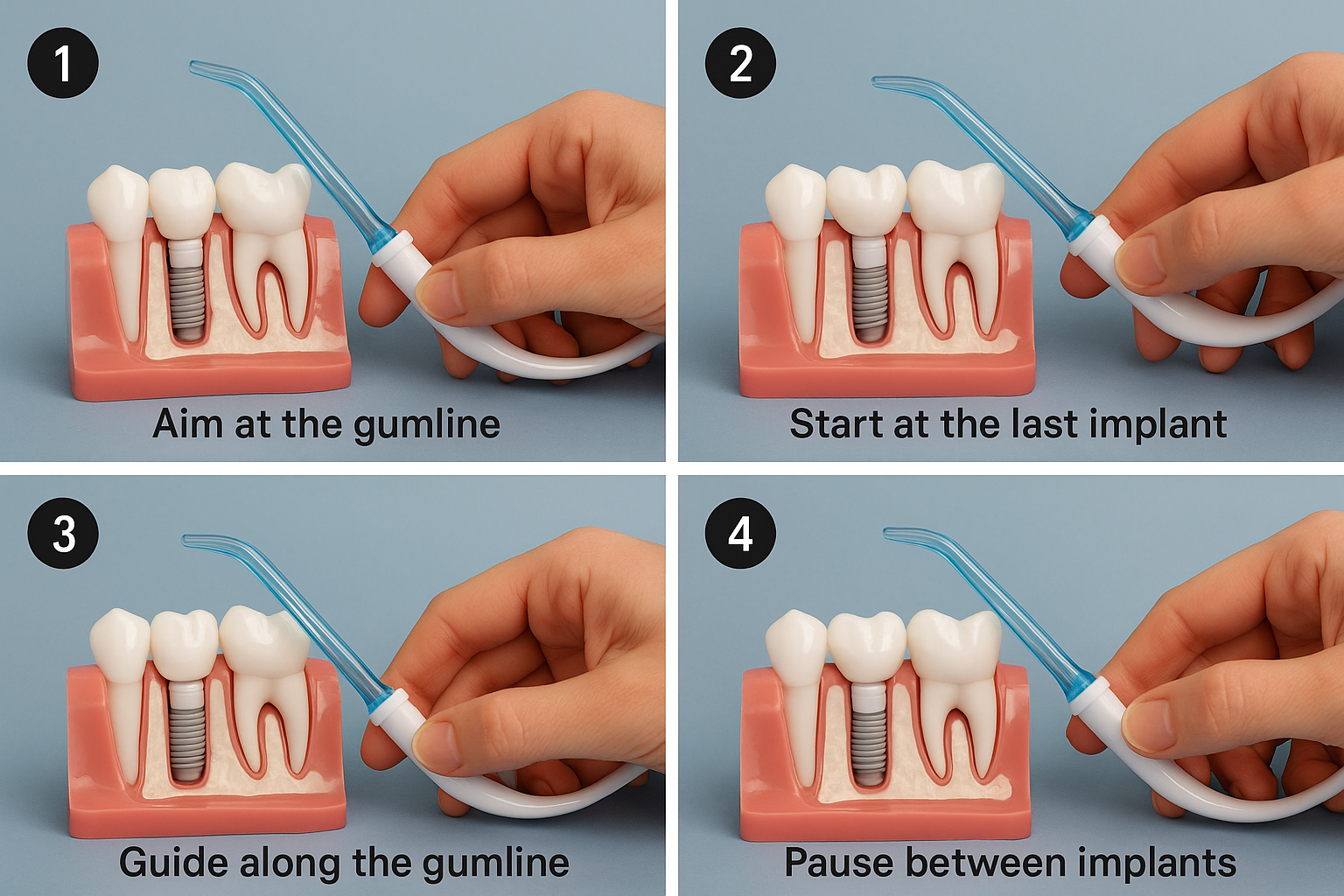
Not all implants are the same, and your flossing technique may need to be adjusted based on the type of restoration you have.
Single Implant Crowns
Cleaning approach:
- Treat similar to natural teeth but with gentler pressure
- Pay special attention to the gum line where the crown meets the tissue
- Use interdental brushes if there are gaps between the implant and adjacent teeth
Implant-Supported Bridges
Special challenges:
- Multiple connected crowns create more hiding spots for bacteria
- Cleaning under the bridge requires special tools
- More surface area means more time needed for proper cleaning
Recommended tools:
- Super floss or floss threaders to clean under the bridge
- Water flosser with orthodontic tips
- Interdental brushes in various sizes
Full Mouth Implant Restorations
If you have permanent teeth in a day or full mouth implants, your cleaning routine will be more extensive but follows the same principles.
Key considerations:
- More implants mean more time needed for proper care
- May require multiple types of cleaning tools
- Professional maintenance becomes even more critical
- Consider investing in a high-quality water flosser with multiple tips
Technology and Innovations in Implant Care
The field of implant maintenance continues to evolve, with new technologies making home care easier and more effective.
Advanced Water Flossers
Smart water flossers now offer:
- Pressure sensors to prevent over-aggressive cleaning
- Timer functions to ensure adequate cleaning time
- Multiple pressure settings for different areas
- Bluetooth connectivity to track your routine
Antimicrobial Innovations
New products include:
- Implant-specific toothpastes with hydroxyapatite
- Probiotic rinses designed to promote healthy oral bacteria
- Ozone therapy for home use
- Light-activated antimicrobial treatments
Professional Monitoring Tools
Your dental team may use:
- Digital periodontal probing for precise measurements
- Bacterial testing to identify specific problem organisms
- 3D imaging to monitor bone levels around implants
- Laser therapy for treating early-stage complications
Building Your Long-Term Success Plan
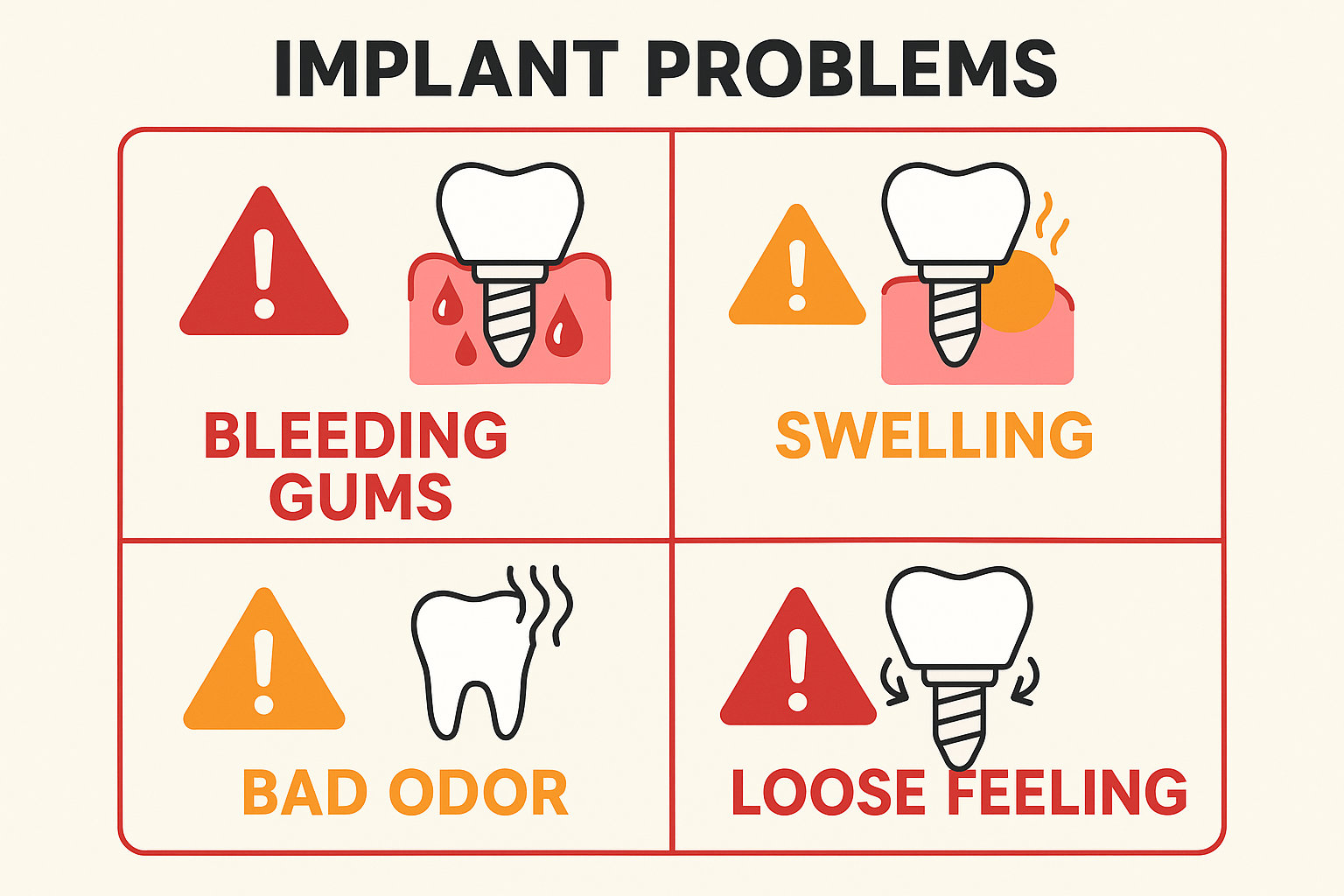
Successful implant maintenance requires a comprehensive approach that goes beyond just flossing. Here’s how to build a routine that will keep your implants healthy for decades:
Daily Routine Checklist
Morning (5 minutes):
- Gentle brushing with soft-bristled toothbrush
- Antibacterial rinse
- Quick visual inspection for any changes
Evening (10-15 minutes):
- Thorough water flossing around all implants
- Interdental brush cleaning where needed
- Comprehensive brushing
- Final antimicrobial rinse
Weekly Deep Cleaning
Once per week:
- Extended water flossing session (15-20 minutes)
- Traditional floss supplementation in problem areas
- Tongue cleaning to reduce overall bacterial load
- Review and photograph any areas of concern
Monthly Self-Assessment
Check for:
- Changes in gum color or texture
- New areas of bleeding or sensitivity
- Shifts in how your bite feels
- Overall comfort and function
Quarterly Professional Care
Professional appointments should include:
- Comprehensive implant examination
- Professional cleaning with implant-safe instruments
- X-rays as needed to monitor bone levels
- Adjustment of home care routine based on findings
- Discussion of any concerns or changes
Lifestyle Factors That Affect Implant Health
Your daily habits and lifestyle choices significantly impact the success of your implant maintenance routine.
Nutrition for Implant Health
Foods that support implant health:
- Vitamin C-rich foods (citrus, berries, leafy greens) support gum health
- Calcium and vitamin D (dairy, fortified foods) maintain bone density
- Omega-3 fatty acids (fish, walnuts) reduce inflammation
- Antioxidant-rich foods (colorful vegetables) fight bacterial damage
Foods to limit:
- Sugary snacks that feed harmful bacteria
- Sticky foods that cling to implant surfaces
- Very hard foods that could damage restorations
- Acidic beverages that can irritate gum tissues
Habits That Help
Positive lifestyle choices:
- Staying hydrated to maintain healthy saliva flow
- Regular exercise to improve circulation
- Stress management to reduce inflammation
- Adequate sleep for optimal immune function
Habits That Harm
Risk factors to address:
- Smoking or tobacco use dramatically increases implant failure risk
- Teeth grinding can overload and damage implants
- Poor general health (diabetes, heart disease) affects healing
- Medications that reduce saliva flow or immune function
Troubleshooting Common Flossing Challenges
Even with the best intentions, you might encounter obstacles in your implant flossing routine. Here’s how to overcome common challenges:
“I Don’t Have Time”
Reality check: Implant failure can cost thousands and require months of treatment. The 10-15 minutes daily for proper care is a wise investment.
Time-saving strategies:
- Use a water flosser while showering
- Keep travel-sized tools at work for midday cleaning
- Set phone reminders until the routine becomes automatic
- Consider electric toothbrushes with built-in timers
“It’s Too Difficult”
Common solutions:
- Ask your dental hygienist for a hands-on demonstration
- Practice the technique during your professional cleaning appointments
- Start with easier-to-reach implants and gradually work up to more challenging areas
- Consider tools with ergonomic handles if you have dexterity issues
“My Gums Always Bleed”
Possible causes and solutions:
- Too much pressure: Reduce force and increase frequency instead
- Wrong tools: Switch to softer floss or lower water flosser pressure
- Inflammation: Increase cleaning frequency and see your dentist sooner
- Technique issues: Request additional training from your dental team
“I Keep Forgetting”
Habit-building strategies:
- Link flossing to an existing habit (like brushing your teeth)
- Use smartphone apps to track your routine
- Keep flossing tools visible as a reminder
- Set up a reward system for consistent daily care
When to Upgrade Your Implant Care Routine
Your implant care needs may change over time. Here are signs it might be time to upgrade your routine or tools:
Routine Upgrades Needed When:
Your current routine isn’t working:
- Persistent bleeding or inflammation despite consistent care
- Recurring professional cleaning recommendations for the same areas
- Development of peri-implant mucositis or early peri-implantitis
Your implants have changed:
- Additional implants placed
- Changes in restoration type (single crown to bridge, etc.)
- Gum recession exposing more implant surfaces
Your life circumstances change:
- Aging affecting dexterity or vision
- Medical conditions impacting oral health
- Medications affecting saliva flow or immune function
Tool Upgrades to Consider:
Technology improvements:
- Newer water flosser models with better pressure control
- Smart toothbrushes that guide your cleaning routine
- Specialized interdental brushes for changing gum contours
Professional recommendations:
- Prescription antimicrobial rinses
- Custom cleaning tools for your specific implant configuration
- Professional-grade home care products
The Future of Your Implant Investment
With proper care, your dental implants can truly last a lifetime. Studies show that well-maintained implants have success rates exceeding 95% at 20+ years. Your daily flossing routine is the foundation of this success.
What Success Looks Like
Healthy implants at 10+ years:
- No pain or discomfort during normal function
- Stable bone levels on X-rays
- Healthy, pink gum tissue with no bleeding
- Natural appearance and feel
- Full chewing function restored
Planning for the Long Term
Consider these factors:
- Aging: Your care routine may need modifications as you age
- Technology: New tools and techniques will continue to emerge
- Professional care: Maintain relationships with implant-experienced dental professionals
- Health changes: Adjust your routine as your overall health evolves
Protecting Your Investment
Remember, your implants represent a significant financial and personal investment in your quality of life. The small daily effort required for proper flossing and care pays enormous dividends in:
- Confidence in your smile and social interactions
- Function for eating your favorite foods
- Health through proper nutrition and oral wellness
- Savings by preventing costly complications
- Peace of mind knowing you’re protecting your investment
Conclusion
Flossing dental implants isn’t just another item on your oral hygiene checklist—it’s the key to protecting one of the most important investments you’ll ever make in your health and confidence. The techniques and tools we’ve covered in this guide can mean the difference between implants that last a lifetime and costly complications that could have been prevented.
Your journey to optimal implant health starts with understanding that your artificial teeth need just as much care as natural ones—perhaps even more. The daily commitment to proper flossing, combined with regular professional maintenance, creates a powerful defense against the bacteria that threaten your implant investment.
Take action today:
- Evaluate your current flossing routine and tools
- Invest in a quality water flosser if you don’t already have one
- Schedule your next professional cleaning and implant check-up
- Track your daily care routine using tools like our interactive tracker above
Remember, your dental team is your partner in this journey. Don’t hesitate to ask questions, request demonstrations, or seek help if you’re struggling with any aspect of your implant care routine. We’re here to help you succeed and maintain that confident, beautiful smile for years to come.
Your implants gave you back your smile—now it’s time to give them the care they deserve. Start implementing these flossing techniques today, and enjoy the peace of mind that comes with knowing you’re protecting your investment for life.

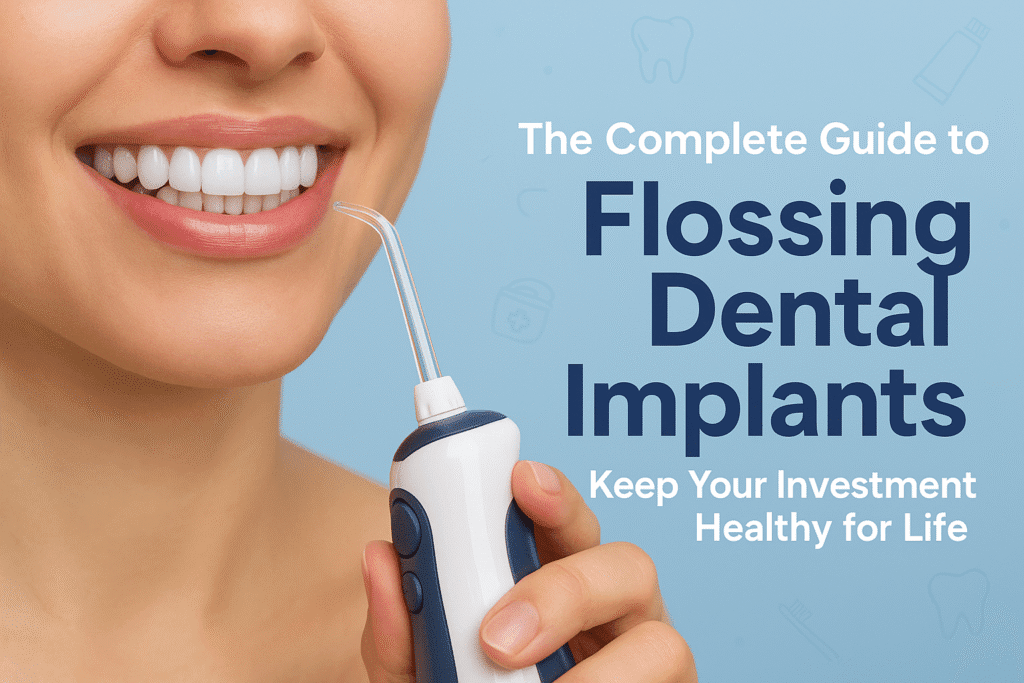
Leave a Reply
Share your thoughts or ask a question about dental implants. Your email address will not be published.